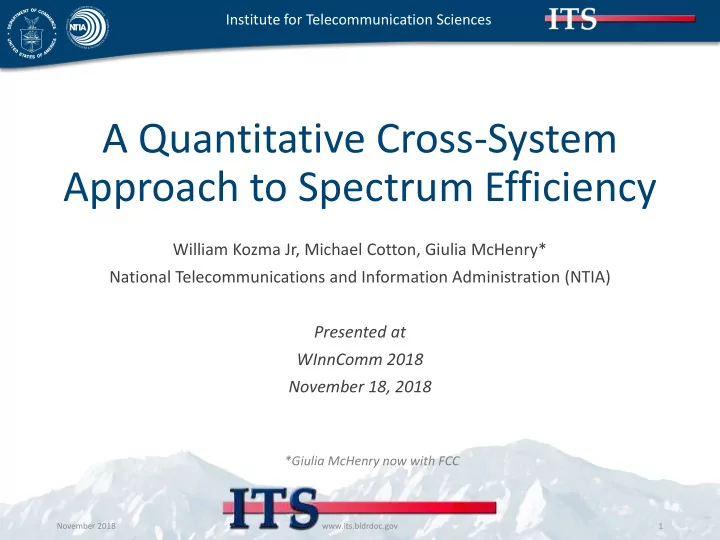

Institute for Telecommunication Sciences A Quantitative Cross-System Approach to Spectrum Efficiency William Kozma Jr, Michael Cotton, Giulia McHenry* National Telecommunications and Information Administration (NTIA) Presented at WInnComm 2018 November 18, 2018 *Giulia McHenry now with FCC November 2018 www.its.bldrdoc.gov 1
Institute for Telecommunication Sciences Background ● Increasing demand for spectrum by both federal and commercial services necessitates more efficient use of this finite resource ● Motivating or incentivizing spectrum efficiency is different for federal services than it is for commercial services ● In order to improve spectrum efficiency, one must be able to define it, quantify it, change it, and evaluate the cost (or the trade-space) associated with changing it November 2018 www.its.bldrdoc.gov 2
Institute for Telecommunication Sciences Objectives ● Establish regulator-oriented SE metrics that fundamentally prioritize agencies’ missions ● Develop SE evaluation framework and tools to enable agencies/NTIA to quantify and understand tradeoffs between current & future technologies, systems, and assignments ● Respond to interest from Hill via proactive SE evaluation that Supports national security and mission effectiveness Establishes best practices for optimal spectrum use and technology innovation Improves opportunities for spectrum sharing November 2018 www.its.bldrdoc.gov 3
Institute for Telecommunication Sciences Approach – Orthogonal Dimensions ● Spectrum efficiency refers to the effective use of spectrum in accomplishing the mission, in space, time, and frequency dimensions. ● Effectiveness depends on the goal and the service performed while using spectrum. Key Considerations: Frequency Space 1. Is the spectrum in actual use throughout the continental United States, geographically? 2. Is the spectrum used continuously over 24 hours or there are times when it is not used? Time 3. Is the frequency of current allocation fully used and fully needed? Is more spectrum needed? Can technology advancements reduce the need? ● Is the mission served – considering all 1-3 above? November 2018 www.its.bldrdoc.gov 4
Institute for Telecommunication Sciences Approach –Parameters and Metric ● Many historical approaches ● SE can be defined as: Spectrum producing utility Spectrum assigned or occupied . ● Offer variety of metrics (in contrast to one-size-fits-all) to evaluate systems according to purpose, technology, and stage of deployment ● Incorporate system/service design requirements into determining utility requirements , e.g., minimum SNR or SINR, Intended range, minimum population coverage ● Improve information about systems November 2018 www.its.bldrdoc.gov 5
Institute for Telecommunication Sciences Spatial Dimension: Occupancy ● Assigned area ( A ) ● Occupied area ( Z ) in which the detected signal power will exceed a specific level; Z size and shape may change with time; Z is the union of the two areas ● Fraction of total space {assigned, occupied} is { A , Z} divided by total analysis area ( Ω ) ● Identify white space November 2018 www.its.bldrdoc.gov 6
Institute for Telecommunication Sciences Spatial Dimension: Utility ● Detectable energy does not imply utility, e.g., there is an SNR or SINR requirement ● Define utilized space as area where utility requirement (i.e., planned performance requirement) is achieved ● Quantify inefficiencies of occupied space, ε = U / Z, and assignment/license, α = U / A November 2018 www.its.bldrdoc.gov 7
Institute for Telecommunication Sciences Spatial Dimension: Disparate Services ● Disparate systems sharing spectrum increases spectrum utility ● Define a spatial compatibility matrix to capture area in which both systems achieve utility ● Motivate coexistence between disparate systems November 2018 www.its.bldrdoc.gov 8
Institute for Telecommunication Sciences Frequency Dimension: Single System ● Construct the problem in a similar fashion as in the Spatial Dimension ● System has a frequency area, A, and its emissions mask defines its frequency occupancy, Z ● The Utility Bandwidth, or Required Bandwidth, U, is defined P U RSEC A Z f November 2018 www.its.bldrdoc.gov 9
Institute for Telecommunication Sciences Frequency Dimension: Band Efficiency ● Increase spectrum utility of a band, i.e., band packing or sharing ● Capture adjacent-band system effects by their occupancy of non-allocated frequencies P P Adjacent-Band System f f Band Allocation Band Allocation November 2018 www.its.bldrdoc.gov 10
Institute for Telecommunication Sciences Frequency Dimension: Key Questions ● Are too many channels allocated to a system/service? ● Has too much bandwidth been allocated? ● Is possible interference affecting system performance and/or is the system interfering with others? ● Does new technology exist that can improve system efficiency? November 2018 www.its.bldrdoc.gov 11
Institute for Telecommunication Sciences Summary: Generalized Approach to SE ● SE for Analog systems = {M, U} = {M, B.S.T}, M=Useful effect. Spectrum utilization factor SUE can be defined as = U’/U SUE = (B’ . S’ . T’) / (B . S . T) = B’/B . S’/S . T’/T Where, B’/B = Net spectrum used over total spectrum available S’/S = Net Space needed to be used over total usage space T’/T = Net time used over net available time. ● ITU/CCIR (ITU-R, SM.1046-3) document on SE shows how this definition might be applied to real-world radio systems by modifying the general expression for the specific application of point-to-point microwave, broadcast and other networks. November 2018 www.its.bldrdoc.gov 12
Institute for Telecommunication Sciences Next Steps ● Convene the tiger team to discuss and flesh-out the fundamental approach for SE metrics framework ● Implement an SE framework in a collaborative and fact-based approach for prioritizing bands and/or services Identify band/service and agency points of contact Acquire and validate GMF metadata for the band/service Acquire and analyze service design specifications and performance requirements Develop system models, compatibility matrices, and required metadata for SE evaluation Develop software tools for calculating the efficiency Calculate SE metrics Perform measurements/monitoring to validate November 2018 www.its.bldrdoc.gov 13
Institute for Telecommunication Sciences Challenges ● Poor or lacking information about systems ● Consensus on Utility Performance Criteria Interference Protection Criteria ● Formulation in time dimension, especially with mobile transmitters and receivers ● Formulation of compatibility matrix, where coexistence can be achieved via diverse means (e.g., antenna technology, sense- and-avoid, orthogonality, communications, coordination) November 2018 www.its.bldrdoc.gov 14
Recommend
More recommend